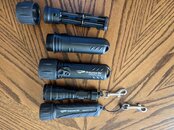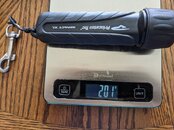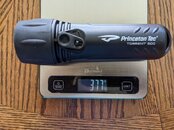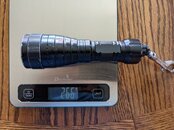2airishuman
Contributor
When I started diving a few years ago I purchased a number of lithium-ion dive lights from Dive Gear Express. They were a mixture of the DGX600 and DGX800 lights. Nearly identical lights are sold under various other brands. They're bright with Dive Gear Express claiming 600 and 800 out-the-front lumens as the model number implies. I have found that they have practical run-times of approximately 50 minutes and approximately 90 minutes, respectively. They use 18650 cells that are removed and recharged in a separate device. My kids use them too. I liked them quite a bit but with time I discovered several significant drawbacks:
After experimenting with several lights, I have settled upon the Princeton Tec Torrent. I use low self-discharge NiMH rechargeable batteries in it -- it takes 8 AAs. Light output is specified as 500 lumens and in practice seems somewhat less than the DGX600 but still more than adequate. I find that I get just over two hours at nearly full brightness and several hours of usable light beyond that, both improvements over the DGX800 and significantly longer than the DGX600. The switch is well thought out and separate from the means of disassembly. The light is somewhat larger and heavier than the DGX600 but shorter than the DGX800. The NiMH batteries have an excellent safety record and can be placed in checked baggage. They hold their charge for years if unused, and it is possible to substitute locally purchased one-use AA batteries should that become necessary.
I also experimented with the Princeton Tec Impact XL but do not believe it meets my needs. It has the twist-style switch that has been problematic for me in the past (when other divers use my light) and has less light output in exchange for somewhat less weight, bulk, and cost.
Past discussions at SB have framed non-lithium-ion lights as non-starters due to insufficient light output and a lack of high-quality diving-oriented choices. While that may have been true in the past, these lights are competitive with lithium-ion lights and offer an alternative for divers who seek one.
- Over five years we have had three of the lights fail, one during its warranty period.
- We had one light flood because the diver using it twisted it the wrong way when trying to turn it on.
- The m/v Conception fire, the loss of a private yacht due to a Lithium-ion battery fire in a power tool, and the ongoing problems airlines have had with lithium-ion battery fires have led me to look for alternatives. My concerns are particularly acute for 18650 lithium-ion cells that are not incorporated into a pack and that therefore lack any sort of cushioning or protection against impact e.g. dropping on the floor, crushing forces, short circuits. To be sure this can be mitigated through careful handling and use of a protective holder, but it requires awareness.
- Lithium-ion cells have relatively high self-discharge rates such that lights using them have to be recharged periodically even if they have not been used.
- Safety aside, air travel with the 18650 cells requires attention to compliance, and a charger or several spares must be carried since there is no practical means of purchasing fully-charged 18650s at a dive destination.
After experimenting with several lights, I have settled upon the Princeton Tec Torrent. I use low self-discharge NiMH rechargeable batteries in it -- it takes 8 AAs. Light output is specified as 500 lumens and in practice seems somewhat less than the DGX600 but still more than adequate. I find that I get just over two hours at nearly full brightness and several hours of usable light beyond that, both improvements over the DGX800 and significantly longer than the DGX600. The switch is well thought out and separate from the means of disassembly. The light is somewhat larger and heavier than the DGX600 but shorter than the DGX800. The NiMH batteries have an excellent safety record and can be placed in checked baggage. They hold their charge for years if unused, and it is possible to substitute locally purchased one-use AA batteries should that become necessary.
I also experimented with the Princeton Tec Impact XL but do not believe it meets my needs. It has the twist-style switch that has been problematic for me in the past (when other divers use my light) and has less light output in exchange for somewhat less weight, bulk, and cost.
Past discussions at SB have framed non-lithium-ion lights as non-starters due to insufficient light output and a lack of high-quality diving-oriented choices. While that may have been true in the past, these lights are competitive with lithium-ion lights and offer an alternative for divers who seek one.








